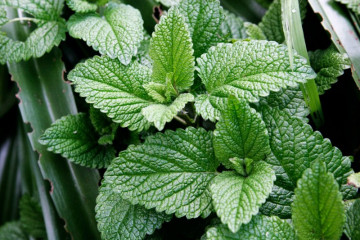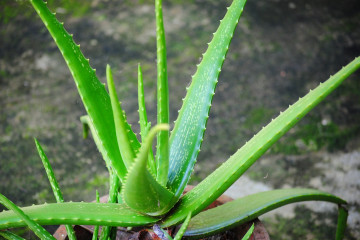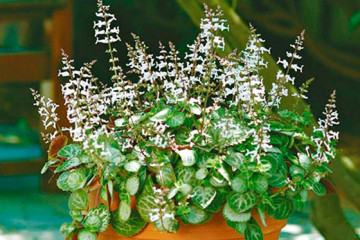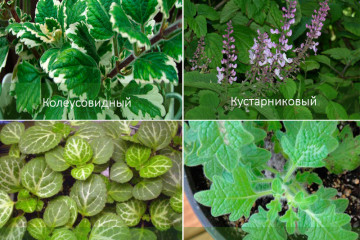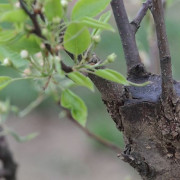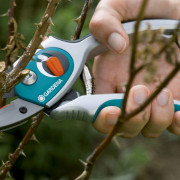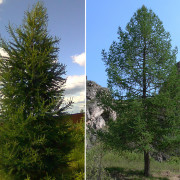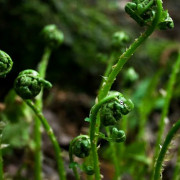Catnip - what kind of plant is it and what it looks like
Content:
Catnip, or catnip, is a really favorite treat for pussies. It not only acts on the brain receptors, but also allows you to adjust the behavioral characteristics of the animal.
Cat mint (Nepetia Cataria) - what kind of plant is it?
This species has several common names: catnip, catnip, lemongrass. It is a herbaceous plant belonging to the Lipoceae family.
In the wild, this herb can be found in almost all regions of Russia. It is like a weed, it lives everywhere: in forests, in fields and meadows. The herb is endowed with an easily perceptible pleasant aroma, consisting of a bouquet of rose and lemon scents.
A short description of what it looks like
Many do not know: catnip - what is it? The species belongs to simple perennials. It grows literally on any soil. Outwardly, it is presented in the form of an erect, stiff stem with a small edge. Ovate leaf plates are surrounded by dense inflorescences that look like a half-umbrella. The flowers are pale blue.
The root system is very powerful and has a branched structure. The flowering period is short - from June to the end of July. The plant contains the following substances in large quantities:
- nepetalactone;
- glycoside;
- saponin;
- tannins;
- vitamin C.
Essential oils are found only in the leaves, the concentration in the stems is close to zero.
What is the difference from regular mint
It is easy enough outwardly to confuse ordinary peppermint and lemongrass. Although the species will look the same, they are still completely different in structure and composition. The main difference is that the main active ingredient is menthol in ordinary mint, and nepetalactone in cat mint.
Despite the external similarity, the plants will differ in smell. Catnip has a tart lemon scent, and mint has a menthol specific aroma.
Another difference between cultures is that the scent of the feline species attracts all kinds of garden insects, but mosquitoes and cockroaches cannot tolerate it.
Common mint does not have these characteristics.
Useful properties of catnip
Before giving catnip to your pet, you need to familiarize yourself with its beneficial and harmful qualities.
With the help of a catnip, breeders often make adjustments to the behavior of pets. In case of aggressive behavior, using this drug can help calm the cat quickly. To speed up the process, special sprays are used, the main active ingredient of which is nepetalactone.
When the animal is depressed, catnip can be used to “awaken” activity. The kitty will instantly become cheerful and friendly. The effect of this herb on the nervous system of a cat depends on the individual characteristics of the organism of a particular pet.
The flower also has an excellent antibacterial effect. When eaten, mint not only cleanses the intestines of all kinds of bacteria, but also helps to improve the work of peristalsis. Also, catnip is an excellent anthelmintic agent.
Breeders recommend using this particular herb in the following situations:
- for the treatment of cats from such dangerous parasites;
- to reduce the consequences of any stressful situation;
- to increase hunger and improve appetite;
- as an assistant for training the animal to a tray or a place to sleep.
But like any potent drug, mint can not only help, but also harm the cat. Experts strongly advise against treating pregnant or lactating cats with catnip. Overexcitation can lead to unconscious harm to the offspring. It is important to closely observe the behavior of the pet under the influence of nepetalactone. At the slightest deviation from the norm, veterinarians recommend abandoning the use of catnip.
Why cats love the smell of this plant
It is scientifically proven that the scent of lemon has a magnetic effect on the cat. The essential components of the plant, when they enter the nasal sinuses of a cat, give a lightning signal to the hypothalamus of the brain and form a wide variety of animal behavior.
The principle of influence on the cat
The smell of catnip leads to a real euphoric reaction. The pet starts spinning and rolling on the floor, accompanying everything with the strongest purr. When this smell is exposed to the brain, the animal very often has hallucinations. Veterinarians compare this reaction to drunkenness. There are a lot of all kinds of individual reactions:
- loud rumbling;
- too active washing;
- unnatural jumping;
- climbing curtains;
- sleep in an unnatural position.
In most cases, the hyperactive behavior continues for 10-12 minutes. After that, the cat usually falls asleep.
The break in the euphoric reaction can last from 30 to 60 minutes and with repeated inhalation, all symptoms will recur.
Is catnip harmful to cats when you don't need to use it?
Even the huge interest of the pet in the catnip does not allow him to eat more than the required amount. The animal has an internal barrier that does not allow eating "euphoric weed" continuously.
The only restriction on the use of catnip concerns pregnant members of the species. Females can become overexcited and the wobbly nervous system will react negatively to stress.
It is important to remember that cats have a natural habit of feeling which plants they need and which ones they don't. Therefore, it makes no sense to restrict the animal in outdoor conditions.
Why the cat doesn't respond to catnip
There is a hereditary feature of some cats, which consists in the lack of interest and reaction of the body to the catnip.
Approximately 30-35% of cats completely lack the receptors responsible for the reaction to this herb. This may be due to age characteristics, but more often, if the reaction did not appear in a young kitten, then it will not work on an adult cat either.
Growing a catnip on a personal plot
Why grow catnip when you can get it at any veterinary pharmacy.The answer to this question is simple: a natural product does not have any chemical impurities and its use in no way can harm your beloved pet. Another reason to start self-cultivation of the species is its decorative qualities and a very pleasant aroma.
Planting a plant can be done in two ways:
- Direct landing in the ground.
- Seedling method.
If you plant seed directly into the soil, it is important to understand that the first shoots will appear no earlier than 14-20 days later. Sowing seeds in open ground can be carried out throughout the spring and even in the fall.
If you follow the rules of care, then an extremely unpretentious plant this year will delight the pet and decorate any garden.
Sowing into soil should be done in a light, drained substrate. Location - sunny side, in extreme cases - partial shade.
Watering plantings is a mandatory procedure. Despite the fact that the plant tolerates drought well, it will definitely not refuse timely watering.
As a top dressing for catnip in the open field, organic and mineral fertilizers have proven themselves well: humus or manure, as well as any superphosphate preparations. We must not forget about the timely loosening after each watering and weeding of all harmful weeds.
If possible, you should not resort to cutting catnip shoots in the first year of life. This will create a stronger, stronger plant.
To achieve flowering already this season, seedlings should be used as planting material. Seeds for seedlings are sown at the very beginning of March. Transplantation into the ground is carried out in May, after the formation of the first true leaves.
By the summer, the bush will grow strongly and if you do not carry out decorative pruning, in the fall it will carry out an independent and maximally abundant self-sowing.
How to grow catnip at home
At home, the cultivation of catnip using the seed method has proven itself in the best way.
To do this, you need to take a seedling box or any suitable container. This species will "like" the most nutritious soil. Although a self-prepared soil mixture and a commercially available universal substrate will differ in composition.
You can take: 1 part of peat, 1 part of sod land, 2 parts of nutrient soil and 1 part of charcoal. Catnip will grow best in pre-disinfected soil. This can be done by simple calcining or by moistening the soil with a weak solution of potassium permanganate.
Step-by-step instructions for growing in a pot
To improve germination, you should pre-soak the seed.
The sequence of actions taken should be as follows:
- before planting, the soil is moistened;
- the seeds are placed in the ground no deeper than 1 cm. At this stage, it is important to follow the sowing pattern in order to avoid thickening of the plantings. The distance between seedlings should not be less than 5 cm;
- the next stage is re-wetting the soil. Spraying with a spray bottle is best suited for these purposes;
- an important condition for good germination is the creation of a "greenhouse effect". To do this, you can put a transparent bag on the container or cover it with any transparent material;
- when the first shoots appear, the cover must be removed;
- after the formation of real leaves, a picking of the landings is carried out;
- transplanting young seedlings into individual pots should be accompanied by pinching the roots. Thanks to this procedure, the plant will grow horizontally, not vertically;
- moving in a larger container is carried out as the catnip grows.
It is important to remember that for the health of the plant, it is important not only to comply with the planting rules, but also to timely and high-quality care of the seedlings.
In order to prevent the soil from drying out, a tray is installed under the pot, which is filled with water as needed. It is advisable to carry out the timely formation of the plant. When the side shoots and leaves are removed, the flower will begin to develop more actively upward.
We must not forget about the necessary feeding of the plantings. Any natural mineral preparations are suitable for these purposes. The first time fertilizer is applied to the soil at the moment the first shoots appear. The second - before the formation of inflorescences, the third - during active budding and the appearance of the first flowers.
If you do not fertilize the soil in a timely manner, the roots of the flower will deplete and the catnip will not be able to develop.
Where does catnip grow in nature?
This culture can be found in many countries around the world. The species feels great in a temperate climate. In forest areas, on mountain slopes, near rivers and water bodies. For example, in the Far East, the catnip has perfectly adapted even to fairly cool weather. Subspecies of catnip have also invaded almost all areas of southern Europe. And in Africa, for example, there are more than 100 plant varieties. About 80 species have been found in India.
Not many people know that lemon catnip can be used not only as the best treat for pets, but also as a medicinal plant endowed with many useful properties.
In folk medicine, catnip is added to a wide variety of teas. They enhance immunity and have excellent anti-inflammatory properties. In pharmaceuticals, the flower is added to pain relievers. When the herb is brewed and taken instead of tea, an excellent expectorant composition is obtained.
Essential oils in catnip also have antimicrobial properties.
In recent years, landscape designers have begun to use catnip to decorate the garden. With the help of this plant, with minimal maintenance, you can achieve an excellent decorative effect and transform almost any home plot.












